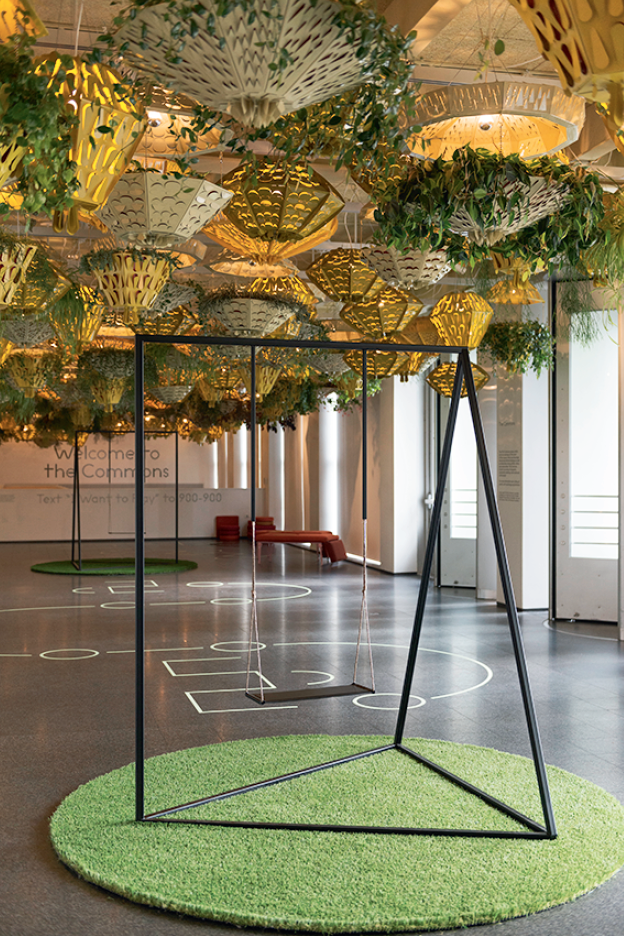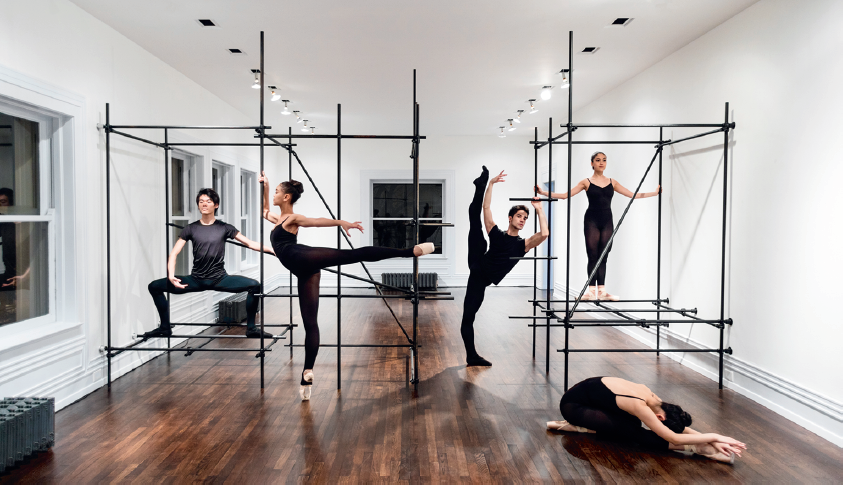Brendan Fernandes
Brendan Fernandes’s production is preoccupied with movement. In his earlier work, it was the movement of culture across geographic boundaries and the visual manifestations of crosscultural global migration and tourism. In the last eight or so years he has focused on the movement of bodies—as informed by the social, political and spacial constructs that affect those spaces. Fernandes works with the codified, formal language of dance in dialogue with the political and social structures that underpin the unwritten rules guiding movement and physical expression in public spaces. Projects like Open Encounter presented in 2018 on NYC’s Highline, Clean Labour and Free Fall 49 (among others) see performative actions enacted in public and gallery spaces, in collaboration with professional dancers.
A natural fit for Fernandes’s hyper collaborative practice is The Commons; a space in the Museum of Contemporary Art Chicago that is mandated to be supportive of dialogue and exchange among artists, the public, Chicago communities and museum visitors.

Brendan Fernandes, installation view, “Commons Artist Project: Brendan Fernandes,” 2019, MCA Chicago, Chicago. Photo: Nathan Keay. © MCA Chicago. Courtesy MCA Chicago, Chicago.
“A Call and Response” is a project in multiple parts. An installation involving sculptural objects, text murals and a soundscape, Open Call saw visitors collaborate with dancers in a performance informed by the space. Open Rehearsals: Calling Time is a series of informal rehearsals in the gallery space where Fernandes and the dancers, attired in botanical print jumpsuits (created through a collaboration with the Rational Dress Society), work towards creating a movement piece that incorporates feedback from the museum audience to be performed at the close of the project.
The structure of the project, which is part exhibition, part residency, is arranged around the dynamics of childhood games where prompts and physical structures support and suggest imaginative play. Drawing from Hide-and-Seek and Follow the Leader gives visitors a familiar framework from which to build or to complicate the understanding of the museum space and their physical and social relationships to those who share in it.
Elsewhere in the museum visitors to Virgil Abloh’s Figures of Speech participate in the commonly understood choreography of the museum with timed entrances and predetermined pathways leading them through exhibition spaces in a linear fashion. “A Call and Response” sits outside this under the lush, semi-permanent installation of From the Tropics with Love by Mexico City-based Pedro y Juana (Ana Paula Ruiz Galindo and Mecky Reuss), a dense constellation of plants and lights that dominates The Commons’s ceiling.
The physical presence of “A Call and Response” is restrained and minimal: a suggestion, a proposition, sometimes a question. Two swings sit on large circles of artificial turf on opposite sides of the large rectangular space. The swings are open geometric forms constructed of matte black, powder-coated steel with a single leather seat suspended from a short chain.
Graphic forms that gesture again towards playgrounds allude to instructions for movement or perhaps are the trace of movement and are made in white vinyl on the concrete floor, while the walls hold two large text murals, again in vinyl: In Calling (1 of 2) and In Calling (2 of 2). The texts provide a prompt to visitors through poetic semi-declarations: “A call to respond / Calling you / to move,” “make formations / supporting the other in movements: WE want a WE”; on the second wall, “a call to respond / calling you / to move / create a public action / hiding and seeking / in movements / WE want a WE.”

The Master and Form, 2018, performance and sculptural installation designed in collaboration with Norman Kelley Architects. Pictured: Satoru Iwasaki, Yuha Kamoto, Andrea de León Rivera, Antonio Mannino and Leah Upchurch. Photo: Brendan Meara. Courtesy the Graham Foundation, Chicago, and MCA Chicago.
Walking through, you begin to hear voices—part of a soundscape made in collaboration with experimental sound artist Alex Inglizian. The voices are varied and diverse, some lyrical and others with a deep, inviting timbre, moving through words and phrases gently imploring you to participate, or at least consider your movements.
“A Call and Response” extends down the staircase, towards MCA’s ground floor where, situated in the staircase, there is a platform emerging from the steps to form a small stage, only enough to hold a single performer. The stair railing is bumped to accommodate, moving the flow of visitors out from the wall and into the centre of the staircase. This sort of subtle reconsideration of a space meant for moving through more than moving in exemplifies Fernandes’s sculptural interventions: suggestive and inviting without being prescriptive.
Incorporating digital communications, text in the space directs you to use your mobile and to text “I want to play” to 900-900 to receive prompts and choreography designed to be used both in the installation and beyond. It didn’t work on my Canadian cell phone, but Chicago poet Kyel Brooks was kind enough to text the number and let me photograph her phone as the prompts came in. The first message read, “Stop and hide in your shadow.” Next we are directed to “turn and seek others. Share your response on social media with #acallandresponse.”
In part and as a whole, “A Call and Response” offers an opportunity to react and reflect through play and interplay with others in the space. Echoed throughout is the imploration “We want a we,” perhaps the most instructive text—a call to consider the collective as we move alone, together. ❚
The Commons Artist Project, Brendan Fernandes: “A Call and Response” was exhibited at the Museum of Contemporary Art Chicago, Chicago, IL, from June 18 to October 13, 2019.
Nadja Pelkey is an artist, writer, cultural worker and sometimes curator working in the border city of Windsor, ON.
To read the rest of Issue 152, order a single copy here.

